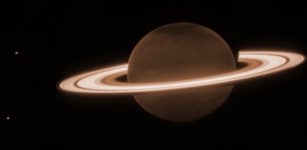Mysterious Mini-Neptunes – Discovered
Eddie Gonzales Jr. – MessageToEagle.com – Researchers have made a significant discovery of mini-Neptunes orbiting four red dwarf stars through observations conducted by a global network of ground-based telescopes and the TESS space telescope.
Diagram of discovered exoplanet orbits. The orbits of exoplanets close to their parent stars tend to become circular over time, but three of the newly discovered exoplanets, except the bottom left, have maintained elliptical orbits despite being over a billion years old. Credit: Astrobiology Center
These four mini-Neptunes exhibit close proximity to their parent stars, and three of them are likely to follow eccentric orbital paths.
This finding contributes valuable insights to the field of exoplanetary research and expands our understanding of the diverse celestial bodies that populate the cosmos.
Planets between the size of Earth and Uranus/Neptune, known as mini-Neptunes, are not found in our solar system.
However, mini-Neptunes are relatively common outside the solar system and are promising targets for atmospheric characterization by the James Webb Space Telescope. What do mini-Neptunes look like?
This study discovered four transiting short-period mini-Neptunes (TOI-782 b, TOI-1448 b, TOI-2120 b, and TOI-2406 b) orbiting red dwarfs through follow-up observations with ground-based telescopes with MuSCATs (a series of Multicolor Simultaneous Camera for studying Atmospheres of Transiting exoplanets). These mini-Neptunes have radii about 2–3 times that of Earth and orbital periods of less than eight days.
In addition, these radial velocity measurements of their parent stars, obtained with the IRD (InfraRed Doppler) on the Subaru telescope, indicate that the upper limit on the masses of these four planets is less than 20 times the mass of Earth. The relationship between the measured radii and the upper mass limits of these mini-Neptunes suggests that they are not rocky planets like Earth. Their interiors likely contain volatiles such as icy materials like H2O and atmospheres.
The team also found that at least three (TOI-782 b, TOI-2120 b, TOI-2406 b) of these four mini-Neptunes are likely to be in eccentric orbits. In general, the orbit of a short-period planet around a red dwarf should be circular due to tidal dissipation. However, three short-period mini-Neptunes around red dwarfs have maintained non-zero eccentricities for billions of years.
One possible interpretation of this is that their interiors are not susceptible to tidal effects. The mass-radius relationship of these four mini-Neptunes suggests that they are not rocky planets. Thus, the interiors of these mysterious mini-Neptunes may be similar to those of Neptune.
Short-period mini-Neptunes are promising targets for atmospheric observations with the James Webb Space Telescope. Further detailed follow-up observations are expected to improve our understanding of the internal compositions and atmospheres of short-period mini-Neptunes.
Written by Eddie Gonzales Jr. – MessageToEagle.com Staff Writer











